Howdy fellow growers! John “Magic” Greenleaf here, bringing you another golden nugget of cultivation wisdom straight from the Rocky Mountains. Today, let’s dive into one of the most crucial aspects of cannabis cultivation: understanding and mastering light intensity. Whether you’re growing indoors with LEDs or soaking in the sun’s natural rays, lighting plays a pivotal role in the health and yield of your cannabis plants. Let’s get those buds bursting with vitality and potency!
The Importance of Light Intensity
Light intensity refers to the amount of light energy received per unit area, and it’s vital in driving photosynthesis—the process through which your plants convert light into growth energy. A well-illuminated cannabis plant will not only grow taller and bushier but also produce bigger, more resinous buds. However, too much or too little light can hinder growth significantly, so finding the sweet spot is essential.
Choosing the Right Lighting System
- LEDs: Energy-efficient and widely customizable, LEDs are perfect for precise control over your grow environment. High-efficiency LEDs can reduce energy consumption by up to 25% and offer a spectrum that mimics natural sunlight—just what the doctor ordered for potent buds.
- HIDs (High-Intensity Discharge): These lights, including Metal Halide (MH) and High-Pressure Sodium (HPS) lamps, are a staple for many seasoned growers. They provide excellent light intensity but tend to consume more power and generate more heat. Adequate ventilation and space are crucial when using HIDs.
- Fluorescent Lights: Ideal for seedlings and clones, they offer lower light intensity and are energy-efficient. However, as plants mature, you’ll need something more powerful to maximize yield.
Optimizing Light Placement
Achieving the ideal light placement in your grow area can significantly impact your cannabis plants’ performance. A few tips:
- Distance: With LEDs, maintain a distance of 12-30 inches depending on the wattage. For HID lights, keep at least 18 inches away during the flowering stage to avoid burning.
- Coverage: Ensure even coverage for all plants. Reflective walls or Mylar can help direct light back onto plants, making the most of every photon.
- Adjustability: Use adjustable light fixtures or pulley systems to easily modify the height as plants grow, ensuring consistent light intensity.
Measuring Light Efficiency in PPFD
Photosynthetic Photon Flux Density (PPFD) is a critical metric for measuring the efficacy of your grow lights. It tells you how much usable light your plants are receiving. Aim for a PPFD of 400-600 μmol/m²/s for vegetative growth and 600-900 μmol/m²/s during flowering for optimal results. Tools like par meters can help in precisely measuring PPFD.
Conclusion: Let There Be Light!
Light is a powerful ally in the quest to grow great cannabis. By understanding and optimizing light intensity, choosing the right lighting system, and fine-tuning placement, you’ll boost your yields and harvest potent, healthy buds. Remember, “The altitude makes us tougher—and so does our weed,” so harness the light and let your cannabis thrive in radiant glory!
Until next time, happy growing! 🌱


Leave a Reply